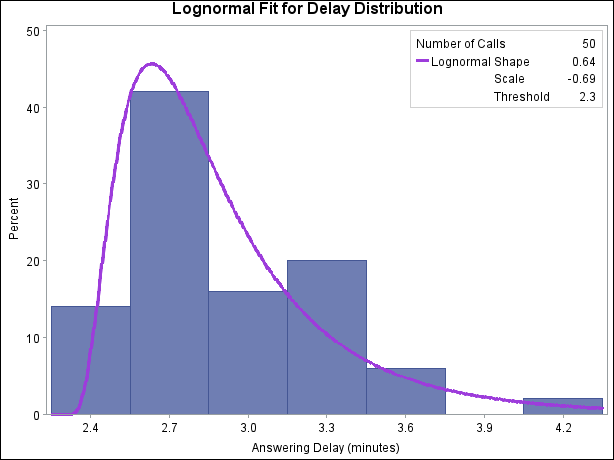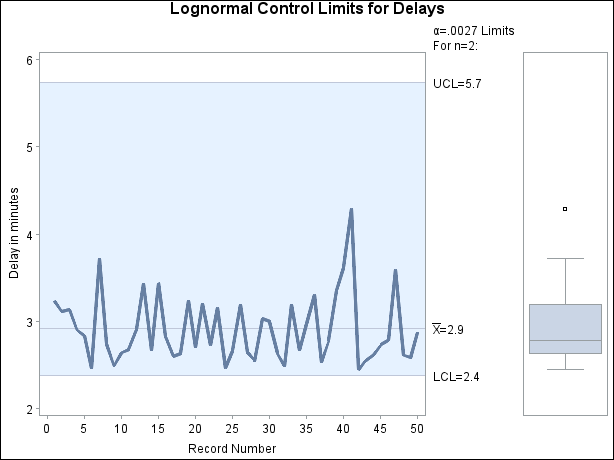The SHEWHART Procedure
Calculating Probability Limits
The OUTLIMITS=
option saves the control limits from the chart in Figure 18.217 in a SAS data set named delaylim, which is listed in Figure 18.218.
Figure 18.218: Control Limits for Standard Chart from the Data Set Calls
The control limits can be replaced with the corresponding percentiles from a fitted lognormal distribution. The equation for the lognormal density function is
![\[ \begin{array}{ll} f(x) = \frac{1}{x \sqrt {2\pi } \sigma } \exp \left( - \frac{(\log (x) - \zeta )^2}{2 \sigma ^2} \right) & x > 0 \end{array} \]](images/qcug_shewhart0413.png)
where  denotes the shape parameter and
denotes the shape parameter and  denotes the scale parameter.
denotes the scale parameter.
The following statements use the CAPABILITY procedure to fit a lognormal model and superimpose the fitted density on a histogram of the data, shown in Figure 18.219:
title 'Lognormal Fit for Delay Distribution';
proc capability data=Calls noprint;
histogram Time /
lognormal(threshold=2.3 w=2)
outfit = Lnfit
nolegend ;
inset n = 'Number of Calls'
lognormal( sigma = 'Shape' (4.2)
zeta = 'Scale' (5.2)
theta ) / pos = ne;
label Time = 'Answering Delay (minutes)';
run;
Figure 18.219: Distribution of Delays

Parameters of the fitted distribution and results of goodness-of-fit tests are saved in the data set Lnfit, which is listed in Figure 18.220. The large p-values for the goodness-of-fit tests are evidence that the lognormal model provides a good fit.
Figure 18.220: Parameters of Fitted Lognormal Model in the Data Set Lnfit
The following statements replace the control limits in DELAYLIM with limits computed from percentiles of the fitted lognormal
model. The 100 th percentile of the lognormal distribution is
th percentile of the lognormal distribution is  , where
, where  denotes the inverse standard normal cumulative distribution function. The SHEWHART procedure constructs an X chart with the modified limits, displayed in Figure 18.221.
denotes the inverse standard normal cumulative distribution function. The SHEWHART procedure constructs an X chart with the modified limits, displayed in Figure 18.221.
data delaylim; merge delaylim Lnfit; drop _sigmas_ ; _lcli_ = _locatn_ + exp(_scale_+probit(0.5*_alpha_)*_shape1_); _ucli_ = _locatn_ + exp(_scale_+probit(1-.5*_alpha_)*_shape1_); _mean_ = _locatn_ + exp(_scale_+0.5*_shape1_*_shape1_); run;
title 'Lognormal Control Limits for Delays';
proc shewhart data=Calls limits=delaylim;
irchart Time*Recnum /
rtmplot = schematic
nochart2 ;
label Recnum = 'Record Number'
Time = 'Delay in minutes' ;
run;
Figure 18.221: Adjusted Control Limits for Delays

Clearly the process is in control, and the control limits (particularly the lower limit) are appropriate for the data. The
particular probability level  associated with these limits is somewhat immaterial, and other values of
associated with these limits is somewhat immaterial, and other values of  such as 0.001 or 0.01 could be specified with the ALPHA=
option in the original IRCHART statement.
such as 0.001 or 0.01 could be specified with the ALPHA=
option in the original IRCHART statement.